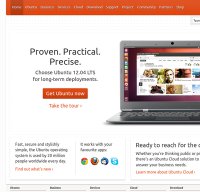
If your system fails to boot for whatever reason, it may be useful to boot it into recovery mode. This mode just loads some basic services and drops you into command line mode. You are then logged in as root (the superuser) and can repair your system using command line tools. If booting into recovery mode does not work you can still use your installation CD (if it is a live cd) as described in LivecdRecovery.
For other versions of Ubuntu Desktop including torrents, the network installer, a list of local mirrors, and past releases see our alternative downloads. Ubuntu 20.10 The latest version of the Ubuntu operating system for desktop PCs and laptops, Ubuntu 20.10 comes with nine months, until July 2021, of security and maintenance updates. Ubuntu Advantage is the professional support package from the experts at Canonical. Get 24x7 support with access to engineers with first-hand experience of your issues. It includes Landscape, the systems management tool, for monitoring, managing, patching, and compliance reporting on all your Ubuntu.
- Switch on your computer.
- Wait until the UEFI/BIOS has finished loading, or has almost finished. (During this time you will probably see a logo of your computer manufacturer.) Note: UEFI fast boot may be too fast to give time to press any key.
- With BIOS, quickly press and hold the Shift key, which will bring up the GNU GRUB menu. (If you see the Ubuntu logo, you've missed the point where you can enter the GRUB menu.) With UEFI press (perhaps several times) the Escape key to get grub menu.
Select the line which starts with 'Advanced options'.
Select the line ending with '(recovery mode)', probably the second line, something like: Cod mod warfare.
- Press Return and your machine will begin the boot process.
After a few moments, your workstation should display a menu with a number of options. One of the options (you may need to scroll down to the bottom of the list) will be 'Drop to root shell prompt'. Press Return with this option highlighted.
The root partition is mounted read-only. To mount it read/write, enter the command
If you have /home, /boot, /tmp, or any other mount point on a separate partition, you can mount them with the command
(This must be done following step 8 so that /etc/mtab is writable.) Alternatively, you could try selecting 'Enable networking' in step 7, though this has been found to cause the system to hang (see https://bugs.launchpad.net/ubuntu/+source/friendly-recovery/+bug/981792).
- Download Ubuntu desktop, Ubuntu Server, Ubuntu for Raspberry Pi and IoT devices, Ubuntu Core and all the Ubuntu flavours. Ubuntu is an open-source software platform that runs everywhere from the PC to the server and the cloud.
- Oct 29, 2020 If you have slow or inconsistent internet, you can find the torrent downloads at the alternate download page (scroll down a bit). Step 2: Create a live USB. Once you have downloaded Ubuntu's ISO file, the next step is to create a live USB of Ubuntu. A live USB basically allows you to boot into Ubuntu from a USB drive.
NOTE 1: If you have Ubuntu Quantal (12.10) or earlier, omit step 4 (the recovery mode menu items are displayed on the top-level menu).
NOTE 2: Wireless data backup. If you reboot, there is no need to hold the Shift key in step 3. The GNU GRUB menu will continue to be displayed automatically on each boot until a normal startup of Ubuntu completes. To configure GRUB so the menu is always displayed, even after a normal startup, see https://help.ubuntu.com/community/Grub2/Setup.
Recovery/Remote
Today we'll be installing Ubuntu on your Chromebook, while preserving your original ChromeOS system.
Ubuntu Site Down For Dummies
We will use a third-party script called crouton to install Ubuntu using a chroot, giving Ubuntu its own 'pretend' root directory system on your machine. This lets you run ChromeOS and Ubuntu side-by-side, being able to flip between the two on-the-fly.
What you'll learn
- How to put your Chromebook into developer mode
- How to install Ubuntu in a chroot on it
- Practical and entertaining uses for Ubuntu on Chromebooks
What you'll need
- A Chromebook (Intel/ARM CPU)
- Some basic command-line knowledge
- At least 1 GB of free storage space
crouton is not part of the Ubuntu project
While we love the value that crouton provides, please note that crouton is a third-party script. It is not provided by nor supported by Canonical nor by the Ubuntu project. Updates to Chrome OS may also make Ubuntu installations inaccessible, as has happened in the past. Use of crouton is at your own risk.
Ubuntu Site Down For Laptop
NVidia Tegra CPUs
The Tegra CPU needs additional drivers not covered in this tutorial. We will add a tutorial covering this in the future (or why not contribute one?).
Ubuntu Site Down For Windows 10
Originally authored by Canonical Web Team

